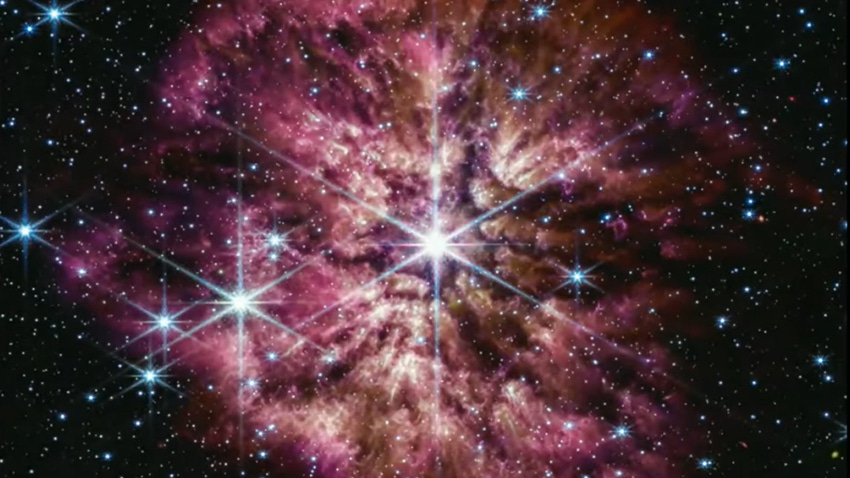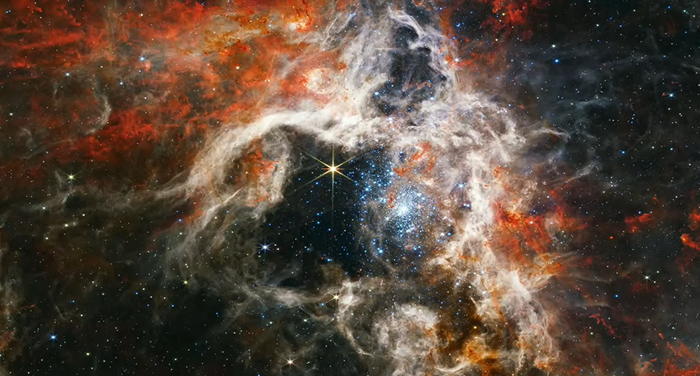SXSW ’23: NASA Unveils New Image from Webb Telescope
Space agency sends all-female astrophysicist team to SXSW 2023

At a Glance
- NASA unveiled the latest James Webb Space Telescope image: a rare Wolf-Rayet star that is soon to go supernova.
- NASA and the European Space Agency sent an all-female astrophysicist team to SXSW 2023.
- The team revealed that the telescope launch was so perfect that its lifespan was extended to 20 years from five to 10 years.
A big, bright star twinkled in the center of a robust plume of purple and pink space dust, surrounded by a string of lesser stars in deep space. This is the rare Wolf-Rayet star, which NASA said is “among the most luminous, most massive and most briefly detectable stars known.”
At SXSW 2023 in Austin, Texas, the image of Wolf-Rayet (WR 124) taken by the James Webb Space Telescope was shared for the first time by a team of astrophysicists from NASA and the European Space Agency − to loud gasps and thundering applause from the audience.
The Wolf-Rayet phase of a star precedes it going supernova. It is in the process of shedding the outer layers, giving off halos of gas and dust. WR 124 is 30 times the mass of the sun and has given off material worth 10 suns thus far. As the gas moves away from the star and cools, cosmic dust forms and glows in the infrared light, which is captured by the telescope.
“The light from that star has been traveling through space for about 15,000 light years … until it hits the detectors on the telescopes,” said Amber Straughn, astrophysicist at NASA’s Goddard Space Flight Center in Greenbelt, Maryland. “At the end of stars like it, they shed … their outer layers out into the rest of the universe.”
“It’s really unique that we can see and study this … for the first time,” added Macarena Garcia Marin, astrophysicist for the European Space Agency. The dust “glows in the infrared, which is exactly what James Webb looks at.”
The telescope is the largest and most complex ever built, thanks to the collaborative work of 20,000 people from 14 countries. NASA led the effort, in partnership with the European Space Agency and Canadian Space Agency. The telescope launched into space in December 2021 and began operating in July 2022.

From left: Moderator Laura Betz, Macarena Garcia Marin, Amber Straughn, Stefanie Milam, Knicole Colon
Here are questions the audience asked the astrophysicist team, which also included NASA’s Knicole Colon and Stefanie Milam.
Question: Is there extraterrestrial intelligent life?
Knicole Colon: There could be life. Is it intelligent? (Jokingly,) is there intelligent life on earth? I guess it depends on how you define intelligence.
I want to believe too, I guess is the bottom line. There are billions of stars out there, which means there are billions of planets. There just has to be, otherwise, (according to a) Carl Sagan quote, ‘It's a waste of space.’
Question: How long does it take to plan, position and take a single photo?
Macarena Garcia Marin: Depending on the object, and depending on how bright or perfect it is, it can take (anywhere) from one hour to tens of hours. … It will take typically half an hour to get to your target and very little time to get a very sharp image. If the source is very big, you have to do many shots and do a mosaic.
Amber Straughn: One of the awesome things about this telescope is how sensitive it is and how efficient it is. We had these beautiful deep fields from Hubble, like the Hubble Ultra Deep Field. If you look at those images from Hubble, which are beautiful and taught us incredible things about the universe, they took 14, 20 days of observing. (For the Webb telescope), we saw that very first image that we released last summer − and we got an image that was even deeper in the infrared in just hours of time. The power of this telescope is how efficient it is in its observational capabilities.

Question: What do you mean by ‘the colors we choose to depict’ (in the Webb telescope images)? … Why don't we see it as it is?
Stefanie Milam: We have an infrared telescope and not a telescope that operates at wavelengths of light that you could see − visible light the way the Hubble telescope does. So in order for us to understand and study any of these given objects at these longer wavelengths of light, which our eyes are not sensitive to, we hone in on ‘colors,’ and we label those colors as to define a given physical process or chemical process so that we can study those details in ways that our eyes can actually see.
Because when these images come in, they are black and white. It is a series of ones and zeroes, lots of pixels. And we take a picture with a given filter, and we take another picture of the same spot with another filter, and we just color one filter green, one filter red, one filter blue, and each of those filters is telling us something different about that object.
We just give them those colors (as) we try to follow the same color coordination as visible light. So for longer wavelengths, we tend to color more red, shorter wavelengths, we tend to color more blue, but it does not necessarily have to be that way. It is just a way that we try to standardize when we make these beautiful images that you see here.
Question: How does the team decide where to point the telescope?
Macarena Garcia Marin: The team does not decide where to point the telescope. Essentially, this is a telescope for the world. … For science operations, the way it works is once a year typically there is a call for proposals. The entire scientific community is invited to send their ideas. They could (say), ‘I want to use this instrument that will serve this target and this is the science I want to achieve.’
All those proposals − this year (we received 1600) − will be reviewed by several panels of experts in all the different scientific topics. It is an interesting process because it is double blind, so the reviewer does not know who is submitting the proposal, or which team is submitting it, which is really great because it removes a lot of biases. … It is all merit-based, and the scientifically interesting proposals are the ones that are chosen.

Question: What is the expected lifespan of the Webb telescope?
Stefanie Milam: NASA had to deliver a space infrared telescope that worked for five years. We also were told that we had to carry about 10 years’ worth of fuel. We do have a fuel-limited mission as we were launching – that was our plan, once we ran out of fuel, to maintain where we are a million miles away from Earth and to unload momentum. That would be the end of mission.
Fortunately, because of our fantastic colleagues who helped us launch our telescope into space on an Ariane 5 rocket, we had such a nominal launch. … It was absolutely flawless. Our launch was so perfect. … We saw our first deployment happen, we saw the solar array unfold, which meant the launch was so perfect we did not even have to tweak which way the telescope was pointing. It was already pointing in the right direction, already going on its journey, and it automatically started deploying itself because it knew that everything was perfect.
So our calculations after our launch, after our insertion into the orbit that we are in, gave us estimates of 20 years of science mission lifetime, which is fantastic for the next generation. (We hope) all the instruments work that long (and) we do not have any other major setbacks with the observatory. I mean, we have a giant sun shield that is made out of basically Happy Birthday balloons. So we are a little fragile but we are doing the best we can to maintain and operate the telescope in a safe way so that we will have science for many decades.
Read more about:
Conference NewsAbout the Author(s)
You May Also Like


.jpg?width=700&auto=webp&quality=80&disable=upscale)
.jpg?width=700&auto=webp&quality=80&disable=upscale)
.jpg?width=700&auto=webp&quality=80&disable=upscale)
.jpg?width=300&auto=webp&quality=80&disable=upscale)
.jpg?width=300&auto=webp&quality=80&disable=upscale)
.jpg?width=300&auto=webp&quality=80&disable=upscale)
.jpg?width=300&auto=webp&quality=80&disable=upscale)
.jpg?width=300&auto=webp&quality=80&disable=upscale)